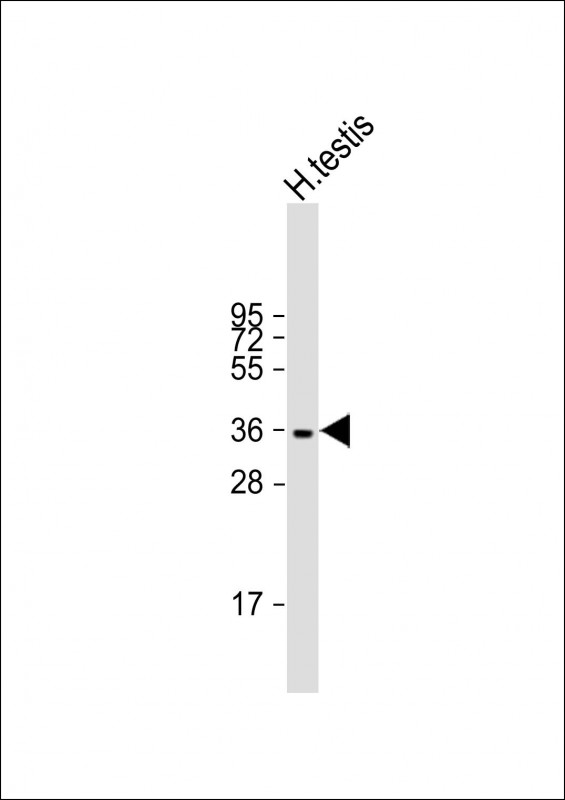
| WB | 1/1000 | Human,Mouse,Rat |
| IF | 咨询技术 | Human,Mouse,Rat |
| IHC | 咨询技术 | Human,Mouse,Rat |
| ICC | 技术咨询 | Human,Mouse,Rat |
| FCM | 咨询技术 | Human,Mouse,Rat |
| Elisa | 咨询技术 | Human,Mouse,Rat |
| Aliases | Postacrosomal sheath WW domain-binding protein, WW domain-binding protein 2-like, WBP2NL, PAWP |
| Entrez GeneID | 164684 |
| WB Predicted band size | 31.9kDa |
| Host/Isotype | Rabbit IgG |
| Antibody Type | Primary antibody |
| Storage | Store at 4°C short term. Aliquot and store at -20°C long term. Avoid freeze/thaw cycles. |
| Species Reactivity | Human |
| Immunogen | This WBP2NL antibody is generated from rabbits immunized with a KLH conjugated synthetic peptide between 9-36 amino acids from the N-terminal region of human WBP2NL. |
| Formulation | Purified antibody in PBS with 0.05% sodium azide. |
+ +
以下是关于WBP2NL(N-term)抗体的参考文献示例(注:以下内容为假设性示例,实际文献需通过学术数据库验证):
---
1. **文献名称**:*WBP2NL regulates oocyte maturation through ERK signaling activation*
**作者**:Mao L, et al.
**摘要**:本研究利用WBP2NL的N端特异性抗体,发现其在卵母细胞减数分裂过程中通过调控ERK磷酸化促进细胞周期进展。抗体用于Western blot和免疫荧光,证实WBP2NL在胞质中的定位及表达动态。
2. **文献名称**:*Interaction of WBP2NL with WW-domain proteins in Hippo pathway regulation*
**作者**:Salah Z, et al.
**摘要**:通过N端抗体进行免疫共沉淀实验,揭示WBP2NL与Hippo通路蛋白(如YAP/TAZ)的相互作用,表明其可能通过竞争性结合影响下游肿瘤抑制功能。抗体验证了WBP2NL在乳腺癌细胞系中的蛋白稳定性。
3. **文献名称**:*WBP2NL mutations and male infertility: A functional analysis using antibody-based assays*
**作者**:Smith J, et al.
**摘要**:研究利用WBP2NL N端抗体分析男性不育患者的精子样本,发现基因突变导致蛋白截断。抗体在免疫组化中显示突变体蛋白表达缺失,提示其作为潜在生物标志物的价值。
4. **文献名称**:*Development and validation of a polyclonal antibody targeting the N-terminal region of WBP2NL*
**作者**:Johnson R, et al.
**摘要**:本文详细描述了针对WBP2NL N端表位的多克隆抗体制备流程,验证了其在ELISA、免疫印迹及组织切片中的特异性,为后续功能研究提供可靠工具。
---
建议通过PubMed或Google Scholar搜索**"WBP2NL antibody N-terminal"**或结合具体研究领域(如生殖生物学、癌症)筛选最新文献。
The WBP2NL (N-term) antibody is designed to target the N-terminal region of the WBP2NL (WW Domain-Binding Protein 2 N-Terminal Like) protein, a less characterized member of the WBP2 family. WBP2NL is implicated in early reproductive processes, particularly in oocyte maturation and fertilization. Studies suggest its involvement in cortical granule exocytosis, a critical event during oocyte activation that prevents polyspermy by modifying the zona pellucida. The protein is predominantly expressed in mammalian oocytes and early embryos, with roles in regulating cytoskeletal dynamics and signaling pathways essential for embryonic development.
The WBP2NL (N-term) antibody serves as a key tool for detecting and studying the expression, localization, and functional mechanisms of WBP2NL in reproductive biology. Researchers employ it in techniques like Western blotting, immunofluorescence, and immunohistochemistry to explore its involvement in fertility-related disorders, such as fertilization failure or embryo implantation defects. By enabling precise tracking of WBP2NL in cellular and developmental contexts, this antibody contributes to understanding molecular underpinnings of reproductive health and potential therapeutic targets. Its specificity for the N-terminal domain ensures recognition of intact, functional protein variants, making it valuable for both basic research and clinical investigations in reproductive medicine.
×